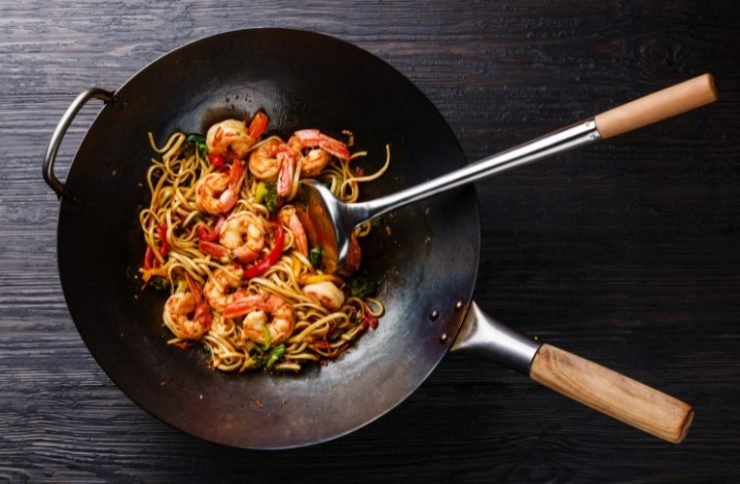Several of my professional cooking years were spent sweating over busy wok stations. And after countless hours of cooking with them, I’ve found the wok to be one of the most versatile pans in the kitchen.
Everything about the wok screams stir-fry. Sloped walls are perfect for tossing ingredients, a wide-open mouth makes for fast evaporation, and the thin construction helps it get scorching hot and stay that way.
So, when it comes to stir-fry, a wok is the clear choice. But are there other cases when you should use a wok instead of a frying pan? Well, that’s what we’re here to find out.
In This Article
The Anatomy Of A Wok
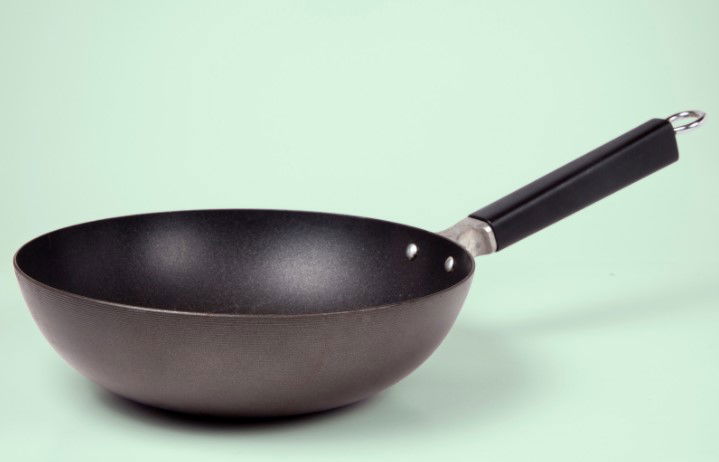
Before we dive in, let’s take a second to get familiar with the design of a wok.
You can get a wok in a wide range of sizes, but they all share a very similar shape and design. If you’ve never seen a wok before, just imagine a very large metal bowl, with one or two handles.
While all woks have a similar shape, there are two distinct versions to choose from. And those are flat bottom and round bottom woks
Round bottom woks are traditional, but because they don’t have a flat bottom they can’t be used on electric or induction cooktops. And when used on a gas range, they should be used with a wok ring. Or, you can use an outdoor wok burner to get a more restaurant-like experience.
A flat bottom wok is the solution for anyone cooking with an electric stove. You can achieve good results with a flat bottom wok, but the round bottom is superior when it comes to smoothly tossing and cooking stir-fries.
No matter which option you’re working with, it’s the deep rounded sides that make the wok so special. This not only allows the pan to hold a lot of food, but it makes it easy to toss ingredients for fast and even cooking.
More Volume
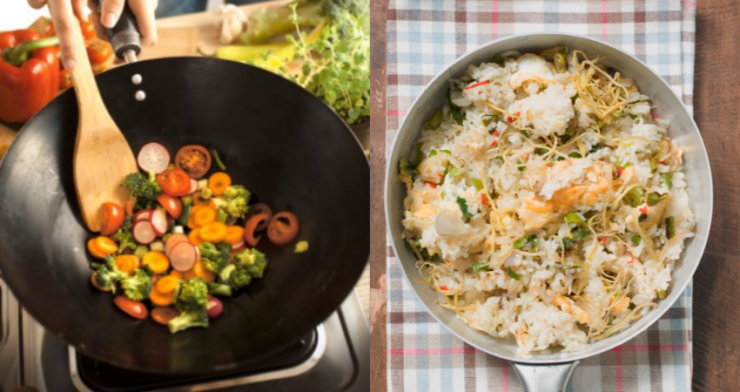
One of the most obvious differences between a wok and a frying pan is the difference in volume. While frying pans generally only have a 1 to 2-inch high sidewall, wok’s are usually around 4-inches deep or more.
This makes the wok much better suited for cooking with large amounts of liquid. So you can use a wok for things you would normally use a pot for like making soup, deep-frying, or steaming.
Less Mess
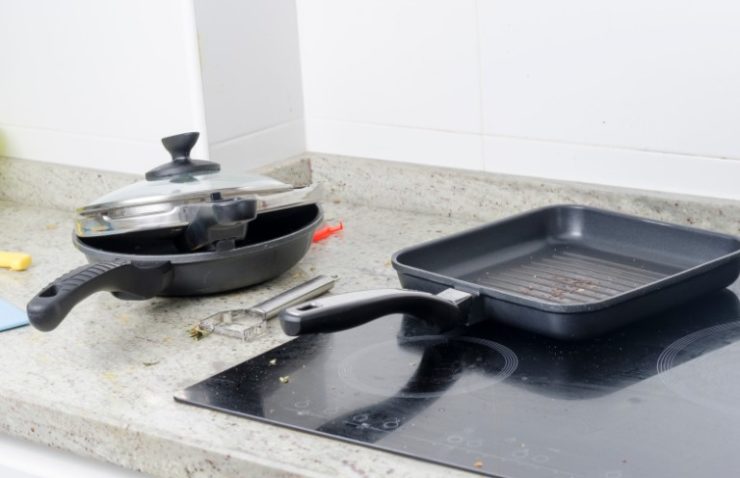
The tall, sloping side walls also help to keep grease or other splatters contained within the pan. If you’ve ever shallow fried, stir-fried, or just cooked bacon in a frying pan, you were probably left with grease splatters covering your cooktop.
With a wok, those grease splatters have a tall wall that they have to climb over before landing and making a mess on your kitchen surfaces. And most of them will end up trapped in the wok where they should be. Leading to less cleanup at the end, which is always a welcome bonus.
Perfect Design For Stir Fry
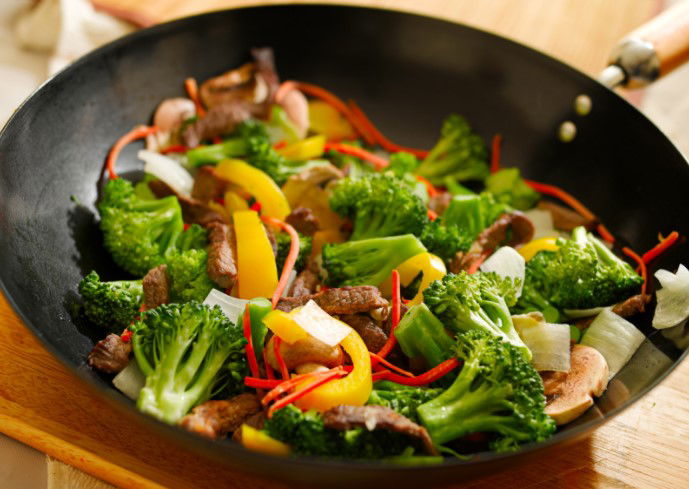
Sure you can make a stir fry in a frying pan, but this is where a wok really shines.
A wok is shaped like a bowl, so when it’s sitting over a burner the very bottom sits close to the flame and it gets very hot. As you move up the sloped sides, that heat gradually decreases.
So, as you flip and toss ingredients up the rounded sides, all of those bite-size pieces are constantly exposed to extremely hot temperatures. This reduces liquid, caramelizes sugars, and browns proteins. All things that add more flavor to a dish.
At the same time, ingredients are spending time at the higher areas of the wok where it’s not quite as hot. This gives them a break from the extreme heat at the bottom so they can cook through without burning.
All of this happens quickly, but it’s the ability to easily keep ingredients in motion and come in contact with different parts of the pan that helps to develop more flavor and cook very evenly.
More Versatile

As I just mentioned, woks are the perfect pan for stir-fries. But, they’re also one of the most versatile pans you can own.
A big part of a wok’s versatility once again comes down to its wide and deep shape. Making it somewhat of a hybrid between a frying pan and a large pot. So, while it’s great for dry cooking, you can also load it up with liquid or oil and use your wok for a wide range of other cooking techniques.
What’s Your Wok Made Of?
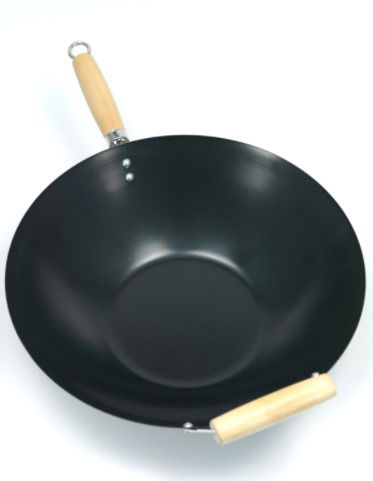

Woks are available in a variety of different materials. And the material you choose can also have an effect on how it can be used.
Carbon Steel
Look at almost any professional wok station and I can almost guarantee that they’ll be using a carbon steel wok. This is the option that offers the most versatility and is generally the least expensive. A winning combination.
The one potential downside to carbon steel is that it requires a little bit of special care in order to keep it from rusting.
Cast Iron
Cast iron woks are thick and heavy. This helps with even heat distribution and can be a good option for deep frying and braising. But the weight makes it difficult to toss ingredients and they are slow to react to temperature changes. Plus, they often require the same special care as carbon steel.
Stainless Steel
Stainless steel woks are often the most expensive of the bunch. The one big benefit you get from stainless steel is that it doesn’t require the special maintenance of carbon steel or cast iron. So you never have to worry about acidic ingredients or soap causing rust problems.
However, stainless steel won’t develop the same patina or nonstick properties that you can achieve with carbon steel. And that can make them more prone to sticking and a little more difficult to use if you don’t have much experience.
Nonstick
Nonstick woks are generally made from aluminum, with a nonstick coating applied to the cooking surface.
The main thing that nonstick woks offer is convenience. Ingredients won’t stick, which makes cooking and cleanup incredibly easy.

I generally advise against nonstick woks because they shouldn’t be used over high heat. And that defeats one of the main purposes of using a wok in the first place.
Frying Pan or Wok? You Should Probably Have Both
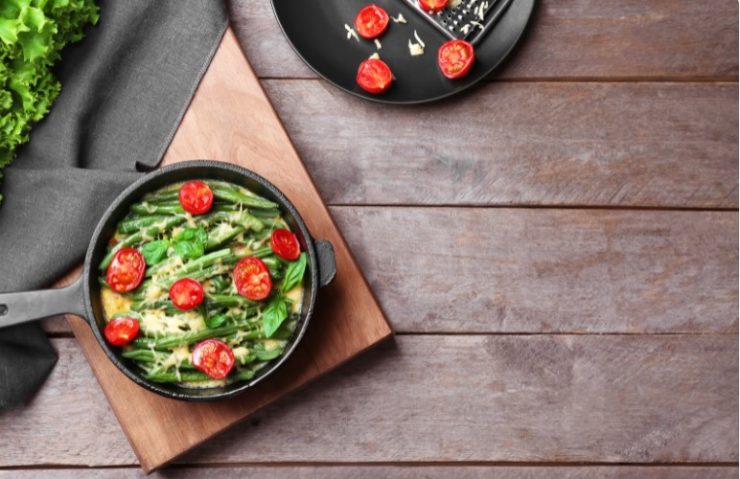
While I think that the wok is one of the most versatile pans in the kitchen, there are still some tasks where a frying pan is really the best option.
When it comes to searing and cooking larger pieces of meat, the flat cooking surface and thick bottom make a frying pan the better tool for the job. And the same goes for many delicate items like fish fillets or fried eggs that benefit from a flat surface and even heat distribution.
So, at the end of the day, a good wok and a good frying pan both deserve a place in any well-outfitted kitchen. But, once you stir fry in a wok for the first time, I don’t think you’ll ever go back.
Frequently Asked Questions
What’s The Best Material For A Wok?
The overall best material for a wok is carbon steel. It’s durable, versatile, inexpensive, and can provide impressive nonstick qualities when cared for and used properly.
Can I Use A Wok On An Electric Stove?
Yes, woks can be used on electric or induction stoves. But, you will want to use a flat bottom wok for better heating and stability on the flat surface.
Why Use A Frying Pan Instead Of A Wok?
Frying pans are ideal when searing and cooking larger pieces of meat like steaks and chops. And they can also be a better option for cooking delicate items like eggs and fish.
